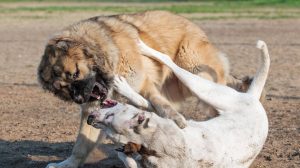In dog training, there is positive reinforcement and negative reinforcement. Both methods are based on the fact that a dog’s behavior has inevitable consequences – the dog should learn that its actions have effects and act accordingly. Negative reinforcements help the four-legged friend to stop behaving in a certain way.

With positive reinforcement, the desired dog behavior is followed by a pleasant consequence for the furry friend: the dog sits down when the command “sit” is given – the dog gets a treat. Negative reinforcement, on the other hand, means that something unpleasant, a negative stimulus that you apply, is removed, and the dog sees: This is what I have to do to make it pleasant. Read the following for more details.
Negative Reinforcement: An Explanation
Negative reinforcement is best explained with an example. The basics are: A negative stimulus for your woof is removed. So, the desired dog behavior is followed by the disappearance of an unpleasant event, signal, or conduct on your part. For example, if you want to teach your four-legged friend the “down” command, you can gently press his rear or back to ask him to lie down. For the dog, pushing is a negative, unpleasant stimulus. When your dog lies down, and you stop holding him down, you remove the negative incentive, and your dog feels better. Lying down is the negatively reinforced behavior here.
Negative reinforcers in dog training
There are numerous variations of negative amplifiers; in this example, the hand on the back. The voice can be negative reinforcers, such as vocalizations like a loud “Oof!” or a throat clearing. Likewise, various signals that you convey through gestures and facial expressions. For example, your dog can recognize facial expressions and moods: scowling at him can negatively affect him.
Example: You are having dinner, and your dog puts his snout on the table longingly. You then punish him with a scowl and a tense posture. Your dog interprets this as uncomfortable and wants you to relax again. If he leaves the table, release your gloomy expression and relax again – the dog will then interpret this as a good thing and will, at best, stay away from the dining table to avoid your evil eye. You have thus negatively reinforced the desired behavior of the dog.
Negative reinforcement is not punishment.
Don’t confuse negative reinforcement with punishment. A negative reinforcer acts as a reward somehow and results in behavior building. The negative reinforcer mustn’t be performed in the form of pain or violent behavior. Spiked collars, for example, negatively reinforce the behavior of not pulling on the leash by hurting your dog when you pull it, and similar methods are taboo in dog training. At best, you will find a good balance between positive and negative reinforcement, and otherwise, pay attention to loving consistency.







